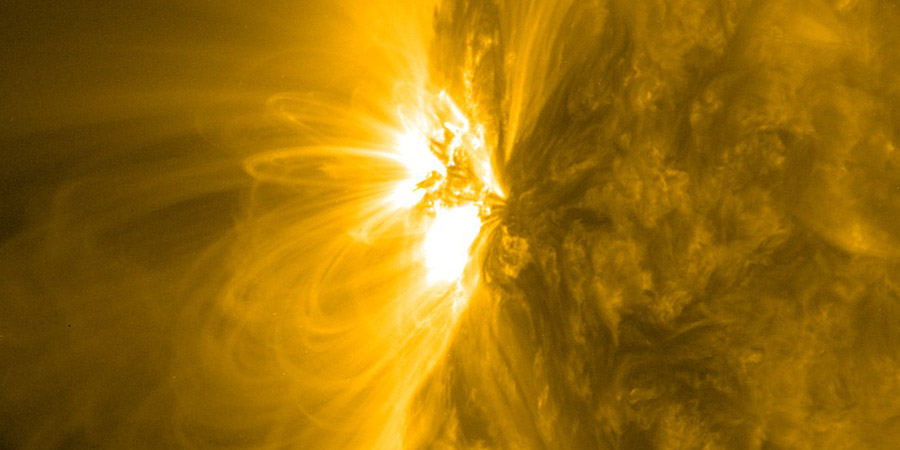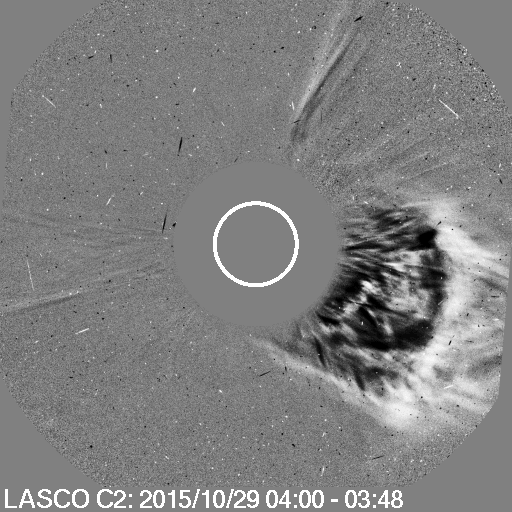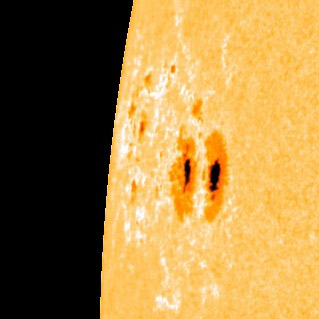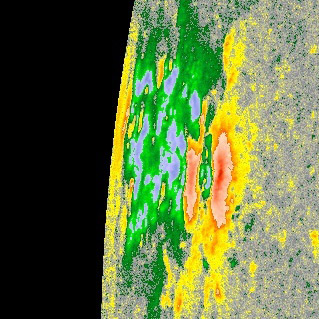S1 radiation storm, sunspot region 2443
Thursday, 29 October 2015 13:59 UTC

A far side eruption just beyond the west limb is responsible for an increase in the high energy protons here at Earth. A minor S1 solar radiation storm is currently in progress.
S1 solar radiation storms are known to cause minor issues with HF radio trough polar regions. The resulting coronal mass ejection is of course directed away from Earth as this was a far side event. Do not be fooled by the increase of low energy protons and electrons on EPAM, this is caused by the parker spiral which makes it possible for energetic particles to reach Earth due to the rotation of the Sun.

Image: SOHO/LASCO C2 coronagraph image showing the far side coronal mass ejection of this morning.
Sunspot region 2443
A new sunspot region which was active on the far side of the Sun has now rotated into view. It has recieved sunspot number 2443 from the NOAA SWPC. There is some faculae surrounding this sunspot region which indicates it might have decayed a bit already. It is still hard to accurately analyse this sunspot region due to it's proximity near the east limb. We nonetheless can not exclude an M-class solar flare from this sunspot region due to the activity it displayed while on the far side.


Images: SDO/HMI imagery showing sunspot region 2443.
Thank you for reading this article! Did you have any trouble with the technical terms used in this article? Our help section is the place to be where you can find in-depth articles, a FAQ and a list with common abbreviations. Still puzzled? Just post on our forum where we will help you the best we can!
Current data suggests there is a slight possibility for aurora to appear at the following high latitude regions in the near future
Arkhangelsk, Norilsk, VorkutaLatest news
Latest forum messages
Support SpaceWeatherLive.com!
A lot of people come to SpaceWeatherLive to follow the Sun's activity or if there is aurora to be seen, but with more traffic comes higher server costs. Consider a donation if you enjoy SpaceWeatherLive so we can keep the website online!

Latest alerts
04:03 UTC - Hemispheric Power Index
The OVATION model predicts the Hemispheric Power Index to reach 50GW at 04:56 UTC
01:45 UTC - Geomagnetic activity
Active geomagnetic conditions (Kp4) Threshold Reached: 01:32 UTC
Tuesday, 1 April 2025
22:51 UTC - Solar flare
Moderate M2.5 flare
22:30 UTC - Radio Blackout
Minor R1 radio blackout in progress (≥M1 - current: M1.45)
07:15 UTC - 10cm Radio Burst
Begin Time: 01/04/2025 06:45 UTC Maximum Time: 01/04/2025 06:45 UTC Duration: 1 minutes. Peak flux: 190 sfu
Space weather facts
| Last X-flare | 2025/03/28 | X1.1 |
| Last M-flare | 2025/04/01 | M2.5 |
| Last geomagnetic storm | 2025/03/27 | Kp5 (G1) |
| Spotless days | |
|---|---|
| Last spotless day | 2022/06/08 |
| Monthly mean Sunspot Number | |
|---|---|
| February 2025 | 154.6 +17.6 |
| April 2025 | 147 -7.6 |
| Last 30 days | 128.8 -21.8 |




